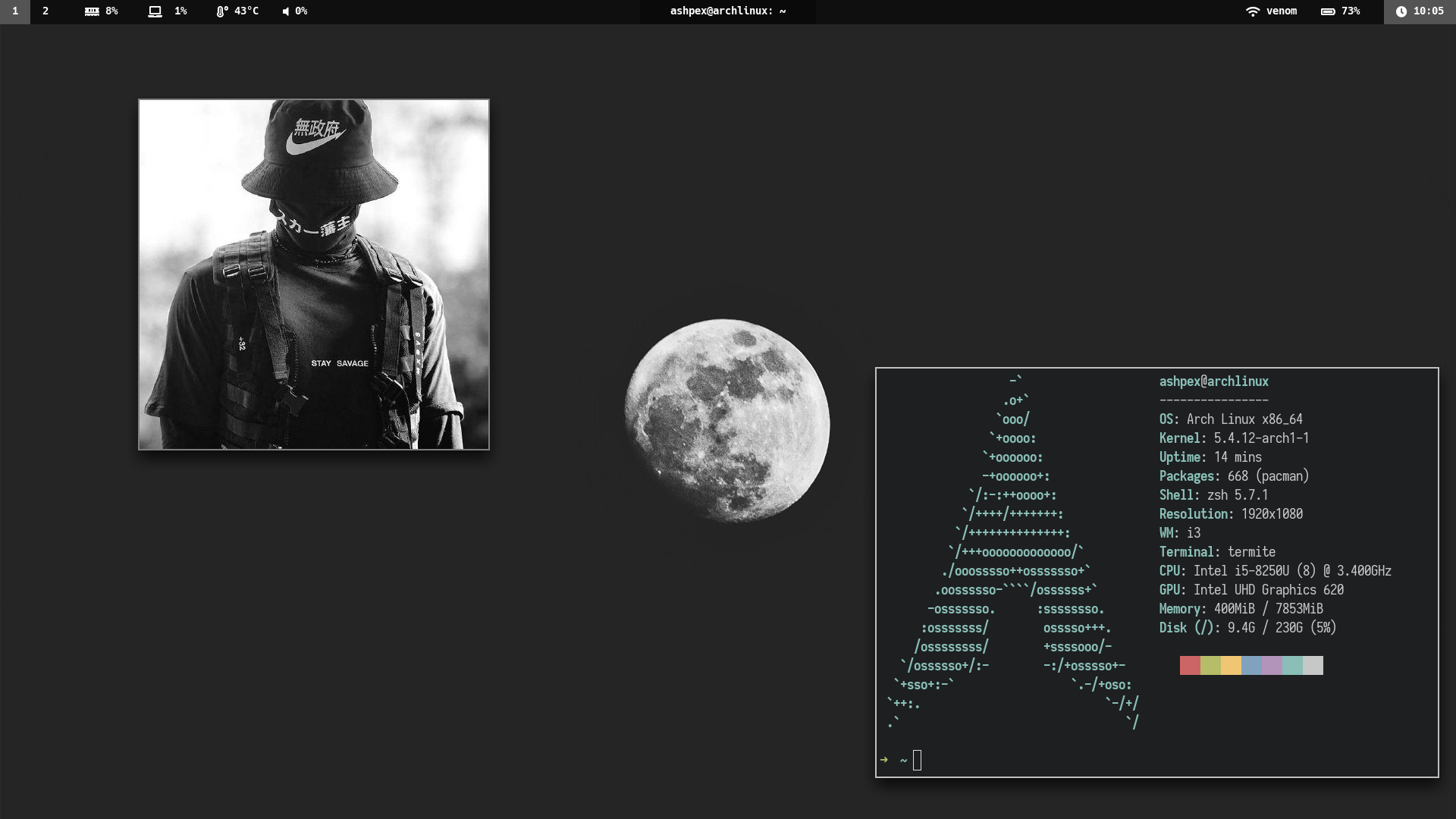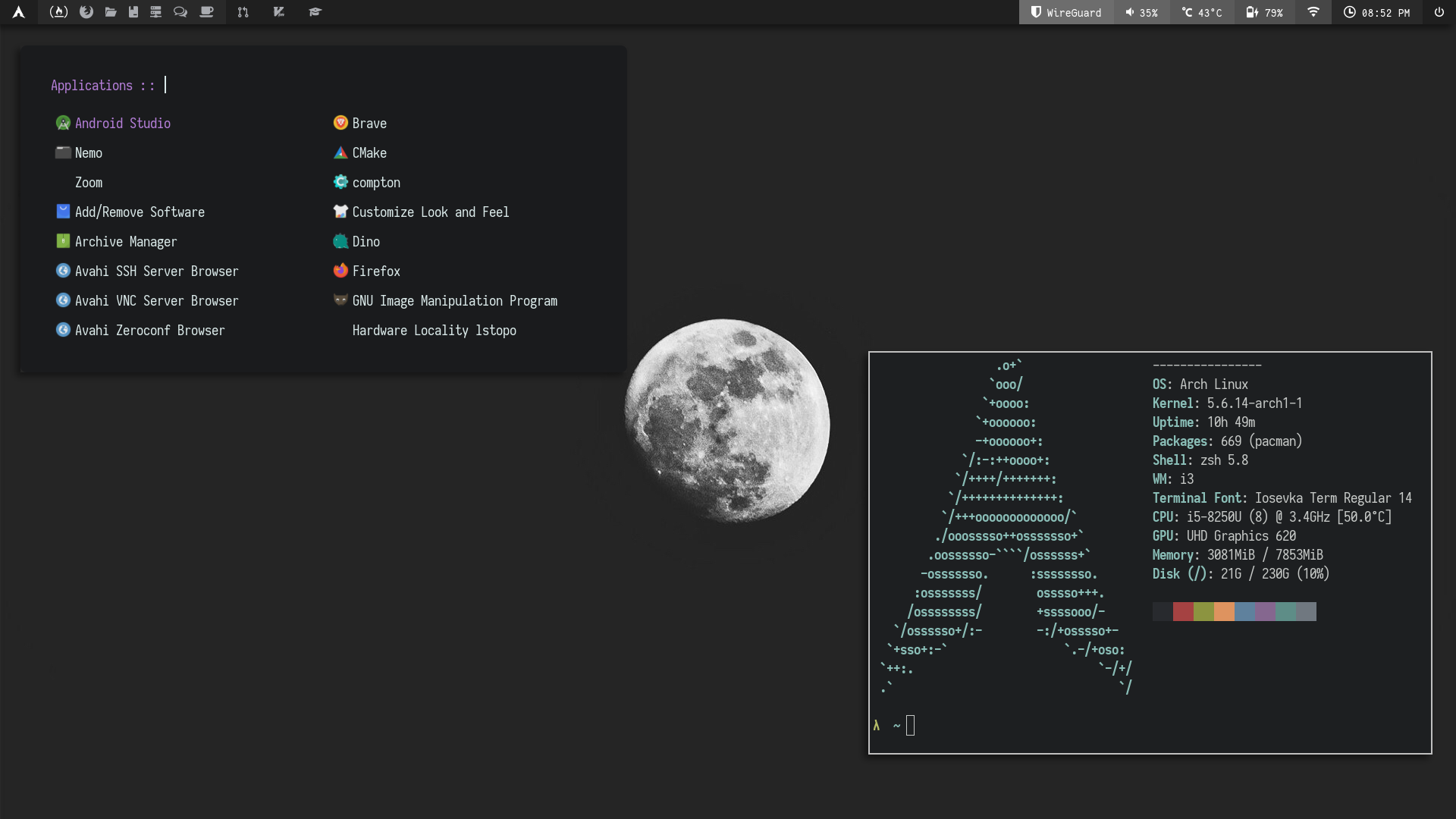Arch Linux Installation

Arch gang rise up.
As you can notice, there are various tutorials in the net for the keyword “Arch installation”. As an Arch user, I will recommmend you to take a look at the Arch wiki for such an installation progess instead. So what is the purpose of this post? You may ask.
Why?
First of all, this post serves as a snippset for my arch installation. I don’t want to forget anything esstensial for my daily workflow incase I have to make a complete reinstall. Secondly, as personalized as this installation guide may seems, it may help new users in some ways.
This installation guide is very outdated. Always follow the official guide from the ArchWiki for porper up-to-date instructions.
Now let’s get started:
/dev/nvme0n1 should be replaced with /dev/sda depending on different hardware.
Setting up
Setting up network
ip link
wifi-menu
Disks partition
lsbk
cgdisk /dev/nvme0n1
| Partitions | Space | Type | Lable |
|---|---|---|---|
| /dev/nvme0n1p1 | 512M | ef00 | boot |
| /dev/nvme0n1p2 | 4G | 8200 | swap |
| /dev/nvme0n1p3 | remaining | 8300 | system |
Format partitions
1. EFI partition
mkfs.fat -F32 /dev/nvme0n1p1
2. Activate swap
mkswap /dev/nvme0n1p2
swapon /dev/nvme0n1p2
3. System partition
mkfs.ext4 /dev/nvme0n1p3
Mount and setting up
mount /dev/nvme0n1p3 /mnt
mkdir /mnt/boot
mount /dev/nvme0n1p1 /mnt/boot
df
Installation
Select mirror
nano /etc/pacman.d/mirrorlist
Place your host of choice on top:
Server = http://abcdxyz.example.com/archlinux/$repo/os/$arch
Install base system
pacstrap /mnt base linux linux-firmware neovim
genfstab -U /mnt
genfstab -U /mnt >> /mnt/etc/fstab
cd /mnt/etc
cat fstab
Chroot into system: setting up timezone, passwd
arch-chroot /mnt
ln -sf /usr/share/zoneinfo/ / /etc/localtime
hwclock --systohc --utc
nvim /etc/locale.gen` then uncomment `en_US.UFT-8`
locale-gen
echo "LANG=en_US.UFT-8" > /etc/locale.conf
nvim /etc/hostname
passwd
useradd -g users -G wheel,storage,power -m ashpex
or
localectl set-locale LANG=en_US.UTF-8
Setting up Bootloader
pacman -S grub efibootmgr
grub-install --target=x86_64-efi --efi-directory=/boot --bootloader-id=GRUB
pacman -S os-prober
grub-mkconfig -o /boot/grub/grub.cfg
Setting up wifi
pacman -S networkmanager wireless_tools wpa_supplicant network-manager-applet
exit
reboot
Install yay
git clone https://aur.archlinux.org/yay.git
cd yay
makepkg -si
Enable ntp
pacman -S ntp
systemctl enable ntpd
systemctl start ntpd
timedatectl set-ntp 1
Install DEs or WM
Gnome
sudo pacman -Syu
sudo pacman -S xorg xorg-server
sudo pacman -S gnome
sudo systemctl start gdm.service
sudo systemctl enable gdm.service
sudo pacman -S pulseaudio pulseaudio-alsa
i3
sudo pacman -S i3-gaps dunst dmenu picom feh mpd mpv ranger rofi scrot neovim xorg xorg-server pulseaudio pulseaudio-alsa alsa-utils nemo alacritty firefox git zathura
yay polybar ranger-git
Install light package to control brightness. It works better than xbacklight and supports Wayland.
XFCE
sudo pacman -S xfce4 xfce4-goodies
Conclusion
That’s pretty much the whole installation of your Arch Linux system. You can customize your OS more later such as things like ricing,… The fun has just begun. Here are some screenshots of my machine over time.
 Screenshot taken in August 2019
Screenshot taken in August 2019
 Screenshot taken in December 2019
Screenshot taken in December 2019
 Screenshot taken in May 2020
Screenshot taken in May 2020
 Screenshot taken in March 2021
Screenshot taken in March 2021
Troubleshooting
Wifi icon 1
Initial Requirements
Hosts
Check the configuration of your /etc/hosts file, a valid configuration looks like this:
#<ip-address> <hostname.domain.org> <hostname> 127.0.0.1 localhost.localdomain yourHostname ::1 localhost.localdomain yourHostnameDevices
You can identify your networking devices like this:
lspci | grep -i netIf your device is not listed, it is maybe an usb-device, so try this command:
lsusbWith the following command you can check the current state of all your network-devices:
ip link
Installation of Required tools
Install the wpa_supplicant tools
sudo pacman -S wpa_supplicantthe wireless tools
sudo pacman -S wireless_toolsInstall the networkmanager
sudo pacman -S networkmanagerInstall the network-manager-applet aka nm-applet
sudo pacman -S network-manager-appletInstall gnome-keyring
sudo pacman -S gnome-keyringConfiguration
Make the networkmanager start on boot:
sudo systemctl enable NetworkManager.service
- Disable dhcpcd
Since networkmanager wants to be the one who handles the dhcpcd related stuff, you have to disable and stop dhcpcd:
sudo systemctl disable dhcpcd.service sudo systemctl disable dhcpcd@.service sudo systemctl stop dhcpcd.service sudo systemctl stop dhcpcd@.service
Enable wpa_supplicant, if you want to use your wireless connection:
sudo systemctl enable wpa_supplicant.serviceAdd your user to the network group:
gpasswd -a <USERNAME> networkTurn off your network interface controllers, in my case eth0 and wlan0:
ip link set down eth0 ip link set down wlan0
Now start wpa_supplicant:
ip link set down eth0 ip link set down wlan0Now Start the networkmanager:
sudo systemctl start NetworkManager.service
Finally, you should see the tray-icon on the top bar.
Sudoers 2
Logging as root
visudo
Add another line after this one
root ALL=(ALL) ALL
With: (by pressing O, then :X to save)
username ALL=(ALL) ALL
